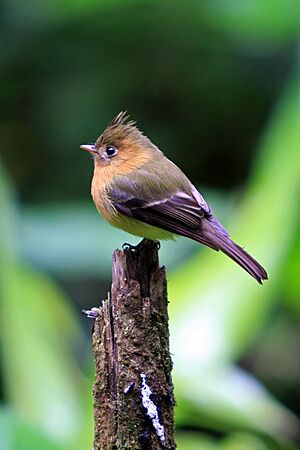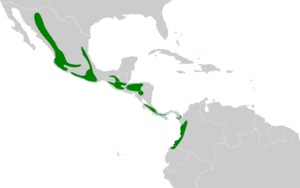Northern tufted flycatcher facts for kids
Quick facts for kids Northern tufted flycatcher |
|
|---|---|
 |
|
| In Costa Rica | |
| Conservation status | |
| Scientific classification | |
| Genus: |
Mitrephanes
|
| Species: |
phaeocercus
|
 |
|
The northern tufted flycatcher is a small bird. It is also known as the tufted flycatcher. Its scientific name is Mitrephanes phaeocercus. This bird is part of the tyrant flycatcher family. You can find it living in high mountain areas. Its home range stretches from northwestern Mexico to northwestern Ecuador. There is another similar bird, the olive flycatcher, but it is now seen as a different species.
Contents
About the Northern Tufted Flycatcher
Where They Live
The northern tufted flycatcher often lives in old mountain forests. It also likes areas with tall new trees. You can find them especially at the edges of forests and in clearings with trees. They usually live at high altitudes. This bird breeds between 700 and 3000 meters above sea level. They are most common from 1200 to 2150 meters high.
Nesting and Reproduction
The female northern tufted flycatcher builds a special nest. It looks like a small saucer. She uses materials like moss, liverworts, and lichens. The nest is built high up, from 4 to 27 meters off the ground. She places it on a branch or vine. The nest is often hidden among ferns, bromeliads, and other plants that grow on trees. The female lays two white eggs. These eggs have brown spots. She sits on the eggs for about 15 to 16 days until they hatch.
What They Look Like
The northern tufted flycatcher is about 12 centimeters (5 inches) long. It weighs around 8.5 grams. Its upper body is olive-green. This includes a cool pointed crest on its head. Its tail and wings are blackish. The wings have two buff-colored bars. The edges of its secondary feathers are also buff. Its chest is an orange-yellow color. This color changes to bright yellow on its belly. Male and female birds look very similar. Young birds have brownish upper parts. Their feathers have buff edges. Their wing bars are orange, and their undersides are paler.
How They Behave
You will usually see northern tufted flycatchers in pairs. They hunt flying insects. They often sit on an open branch, just like a pewee bird. When they catch an insect, they often fly back to the same perch. As they land, they vibrate their tail.
Sounds They Make
This bird has a quick call that sounds like weet weet weet weet. When the sun comes up, its song is very fast and high-pitched. It sounds like bip-bip-bip-dididiup-bip-bip-bibibiseer.
Traveling Birds
The northern tufted flycatcher does not usually migrate long distances. However, it has been seen rarely in the United States. The first time it was recorded there was in Big Bend National Park, Texas. This happened in November 1991. It has also been spotted in Arizona.


